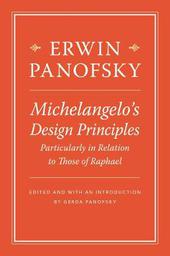
|
Michelangelo's Design Principles, Particularly in Relation to Those of Raphael
Hardback
Main Details
| Title |
Michelangelo's Design Principles, Particularly in Relation to Those of Raphael
|
| Authors and Contributors |
By (author) Erwin Panofsky
|
|
Edited by Gerda Panofsky-Soergel
|
|
Introduction by Gerda Panofsky-Soergel
|
|
Translated by Joseph Spooner
|
| Physical Properties |
| Format:Hardback | | Pages:408 | | Dimensions(mm): Height 229,Width 152 |
|
| Category/Genre | Renaissance art |
|---|
| ISBN/Barcode |
9780691165264
|
| Classifications | Dewey:759.5 |
|---|
| Audience | |
|---|
| Illustrations |
29 b/w illus.
|
|
Publishing Details |
| Publisher |
Princeton University Press
|
| Imprint |
Princeton University Press
|
| Publication Date |
23 June 2020 |
| Publication Country |
United States
|
Description
The first English translation of Erwin Panofsky's long-lost work on Michelangelo In 2012, a manuscript by renowned art historian Erwin Panofsky was rediscovered in a safe in Munich, in the basement of the Central Institute for Art History. Hidden for decades among folders and administrative files was Panofsky's thesis on Michelangelo-originally
Author Biography
Erwin Panofsky (1892-1968) was one of the most eminent art historians of the twentieth century. His many books include Early Netherlandish Painting and The Life and Art of Albrecht Durer (Princeton). Gerda Panofsky is professor emerita of art history at Temple University. She has published on Michelangelo and prepared the revised and enlarged second edition of Erwin Panofsky's Abbot Suger on the Abbey Church of St.-Denis and Its Art Treasures (Princeton).
Reviews"Eloquently translated. . . This is a deeply moving book about a deeply moving artist. . . . Panofsky's analyses carry compelling explanatory power because they are rooted in sensitive observation. . . . [The] presentation offered here takes the readers closer to Michelangelo the artist. We acutely feel the engagement behind the methodology"---Matthias Wivel, The Burlington Magazine "[Gerda Panofsky's] invaluable, sixty-five page introduction provides a fascinating account of Panofsky's life and career and his intellectual trajectory, with special regard to his engagement with Michelangelo studies and his gradual disengagement from that early passion, especially after his move to the United States. . . . Written about two of the most significant artists of all time, Panofsky's Michelangelo's Design Principles offers us a welcome opportunity to observe the maturing of one of the great figures of Art and Intellectual History."---William E. Wallace, Journal of Art Historiography
|